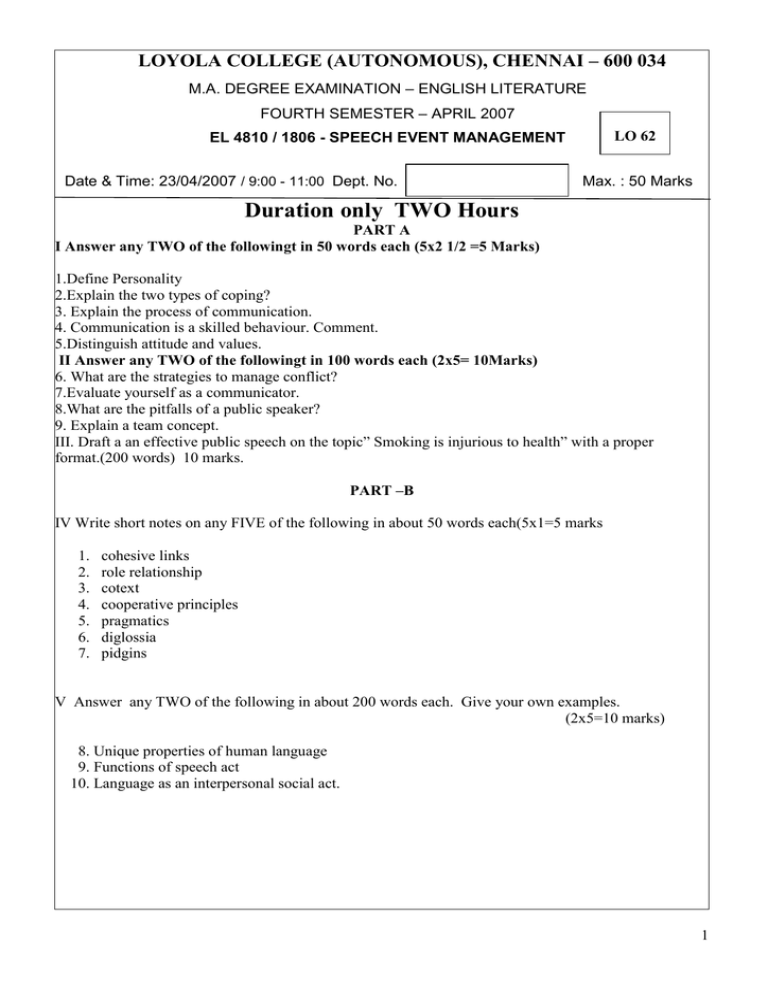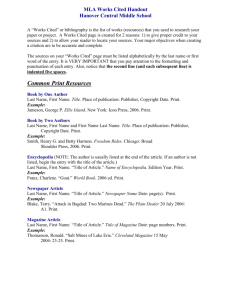LOYOLA COLLEGE (AUTONOMOUS), CHENNAI – 600 034
advertisement

LOYOLA COLLEGE (AUTONOMOUS), CHENNAI – 600 034 M.A. DEGREE EXAMINATION – ENGLISH LITERATURE FOURTH SEMESTER – APRIL 2007 LO 62 EL 4810 / 1806 - SPEECH EVENT MANAGEMENT Date & Time: 23/04/2007 / 9:00 - 11:00 Dept. No. Max. : 50 Marks Duration only TWO Hours PART A I Answer any TWO of the followingt in 50 words each (5x2 1/2 =5 Marks) 1.Define Personality 2.Explain the two types of coping? 3. Explain the process of communication. 4. Communication is a skilled behaviour. Comment. 5.Distinguish attitude and values. II Answer any TWO of the followingt in 100 words each (2x5= 10Marks) 6. What are the strategies to manage conflict? 7.Evaluate yourself as a communicator. 8.What are the pitfalls of a public speaker? 9. Explain a team concept. III. Draft a an effective public speech on the topic” Smoking is injurious to health” with a proper format.(200 words) 10 marks. PART –B IV Write short notes on any FIVE of the following in about 50 words each(5x1=5 marks 1. 2. 3. 4. 5. 6. 7. cohesive links role relationship cotext cooperative principles pragmatics diglossia pidgins V Answer any TWO of the following in about 200 words each. Give your own examples. (2x5=10 marks) 8. Unique properties of human language 9. Functions of speech act 10. Language as an interpersonal social act. 1 VI. Identify the discourse features in the following passage(10 marks) VIJAY GOVINDARAJAN Professor, Tuck School of Business at Dartmouth Topic: Is innovation the key to growth? Vijay Govindarajan Speech It is really a great pleasure and privilege to be a part of this India Today Conclave especially sharing the stage with Dr. Mashelkar and Nandan Nilkeni. The topic for today’s session is – Is Innovation Key to India’s future. I think that is a no-brainer. Answer is yes, yes, yes. The question is how do India and Indian Corporations, how do they need to close that innovation gap. And I was really taken by Queen Jordan’s remark it should be hope gap. That is what we really need to close and one way perhaps we can enter into this conversation is I want every organization in this room including India Today as an organization and every other corporation and organization here. Think about everything you have done in the last 12 months and I say put them in 3 boxes. Box one I say is manage the present. Box two is selectively forget the past and Box three is create the future. Manage the present box one, selective abandon the past box two and creating the future box three. What I find working with organizations is organizations over spent their time in box one and think they do strategy. Is box one important, absolutely. Is box one critical, absolutely. Is box one strategy, no. Strategy is really about how do we create our future in the year 2020. And if you want to maintain leadership in 2020 are they thinks that we need to selectively forget that we are excelling today, the box two challenge. Let me reiterate one thing. While strategy is really about maintaining leadership in 2020 it is not about what you have to do in 2020. It is very much about what an organization needs to be in 2006 across the three boxes so that you introspect 2020. How do we allocate our resources in 2006? How is the organisation’s energy focused in 2006, across the three boxes so that we maintain leadership in the next 15 years. What I find Indian organizations have done is they have over focused on box one. Our challenge is to see how do we expand our scope into box two, box three. Another word for box one is competition for the present. Another word for box two, box three is competition for the future. I say strategy has everything to do with competition for the future and has very little to do competition for the present. Why this distinction is important is there is a fundamental difference in the thinking process between competition for the present and competition for the future. And that fundamental difference is competition for the present is in response to linear changes in the industry. Because the changes are linear, because the changes are incremental the organizational response would be incremental improvements in your current business model. Call it total quality, call it six sigma, call it operational excellence, it is terribly important but that is not strategy. Competition for the future is inherently in response to discontinuous ship. Fundamental ships, non-linear ships because the changes are non-linear the organizational response has to be a non-linear ship as well. If you want to look back in the last 10 years and think about what might be one non-linear ship. If you just want to focus on technology I would say that internet was a discontinuous ship. It led to rule changing business models. 2 Companies like Ebay or Google would not have been possible without the internet. Ours, Yogi Deveshwar was talking about yesterday ITC …. business model which I considered a box two innovation would not have been possible without the internet. Why you said important for corporations to focus on non-linear ships and think about fundamental rule changing moods. You have probably heard the story of encyclopedia Britannica, haven’t you not? Even as late as 1990s encyclopedia Britannica had a virtual lock on its industry with three core components. Components number one – content expertise. They had done research on so many topics. They had wealth of information on so many topics. Whether you believed or not- they had all the noble prize winners on their payroll. Core components number two – packaging capability. They can take that phenomenal content and produce the 500 volume, beautiful looking book set. Core components number three – marketing and distribution capability. They can take that 500 volume books that and reach the consumer better than anyone in the world through their 10000 strong door to door salesmen. Now what happened in 1990 – a non traditional competitor called Microsoft comes into the encyclopedia space with a product called Encarta which is encyclopedia on a CD ROM. Encyclopedia Britannica will not license out their content to Microsoft. So Microsoft went to a second tier player in the encyclopedia industry called Funcan Bagnells. Funcan Bagnells contents was so bad it used to be sold in super market for deep discounts. If you bought enough groceries probably you got a Funcan Bagnells free. So Microsoft got the so called inferior content, jazzed it up with some graphics, put it in a CD ROM and sold it for 50 dollars at a time when encyclopedia Britannica was selling its 500 volume books at for close to 3000 dollars. Now what was the response of encyclopedia Britannica to this discontinuous ship. What they did in the early 90s was encyclopedia Britannica also took its phenomenal content and put inside a CD ROM and gave that CD ROM free of cost to their customers, no charge provided the customer will buy the 3000 dollar bookset. But if you didn’t want the 3000 dollar bookset then the CD ROM costed 500 dollars and their assertion being our content is so much better than the junk that was inside Encarta. You should be willing to pay the premium price. The rest is history as they say. As you well known this great brand Encyclopedia Britannica went bankrupt in the early 1990s. I want to the sort of think for a moment as to why here is a great company, great brand, so successful for so long how did simply become irrelevant in the 90s. You could well imagine Encyclopedia Britannica becoming the Google today. How did they missed this non-linear ship. You could perhaps attribute that to the success of Encyclopedia Britannica itself in 1990. They were so successful in the whole business model they mistook success for validation of the past. So their way of creating the future was to replicate the past or perhaps the problem was in box two. Their core competence book production know how became their core liability. Their door to door distribution model which was phenomenally successful historically created the inflexibility perhaps. Perhaps their problem was perceived cannibalization. Here is a 3000 dollar revenue model they were unwilling to substitute that for a 50 dollar revenue model. That is assuming the size of the industry is fixed. What they missed was non-linear ships fundamentally transformed industry space. *********** 3

